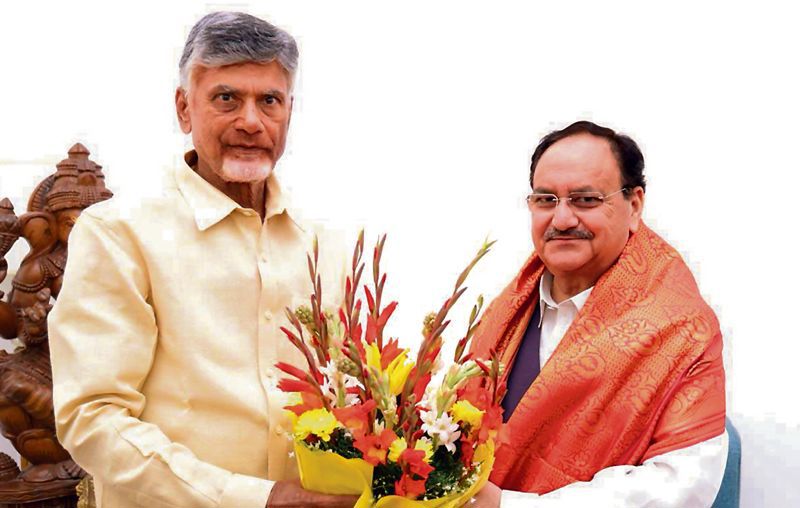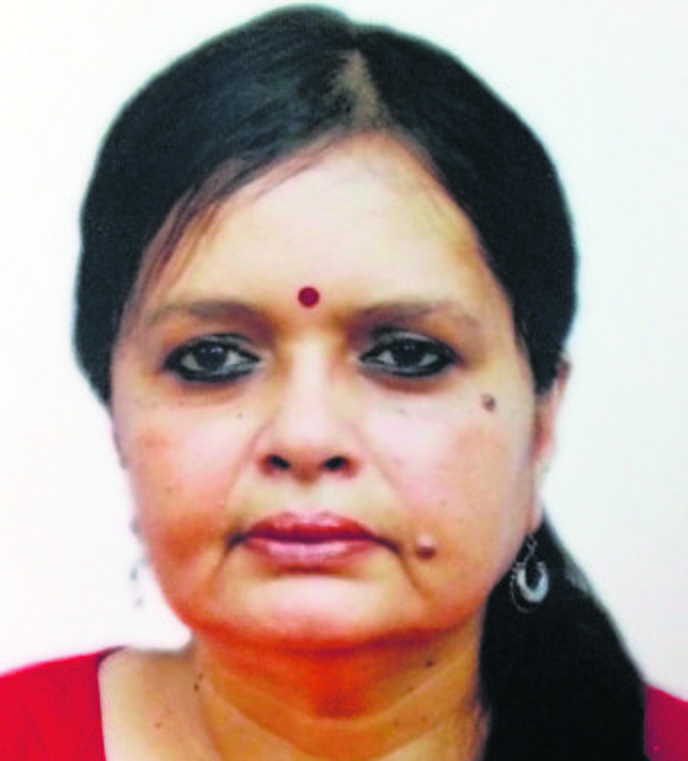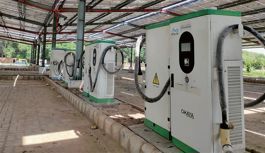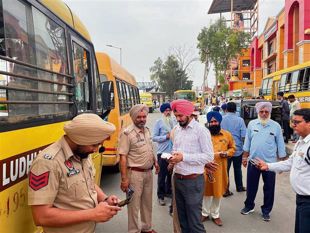
SHIFT: TDP chief N Chandrababu Naidu (left) with BJP president JP Nadda. The southern party returned to the NDA fold recently. PTI
Senior Journalist
A party that bagged 303 out of 543 seats in the 2019 Lok Sabha elections and appears to be in no immediate danger of losing its gains substantially would sit tight in the hope that the 2024 General Election is a done deal. But not the BJP.
The BJP will not live with the notion of geography circumscribing its unbridled ambition. It is acutely aware that most of its seats in 2014 and 2019 were drawn from the north and the west, with some significant payoffs for its persistence and combativeness from the east, but surely it must augment its numbers and footprint. It refuses to be labelled as a ‘Hindi belt’ party, which is tempting to many other parties, especially the Congress, for which decades of glory of ruling over the cow belt is the stuff of nostalgia.
In its impatience to transcend the boundaries etched by the north and the west, the saffron party has seriously tried to penetrate the east and the south in the prelude to this year’s battle. The east is a little more hospitable by virtue of the BJP’s unassailable grip over Assam and stamping its imprint over West Bengal, which it seeks to enlarge. For the BJP, the battle to capture Bengal will not cease with the parliamentary polls. It has to unseat Mamata Banerjee and her party, the Trinamool Congress (TMC), in the 2026 Assembly polls if the sun must rise from the east for the Rashtriya Swayamsevak Sangh. Ideologically, West Bengal is too precious to be thrown away because the last vestiges of the Left’s convictions must be wiped out for the Sangh.
Odisha has a different storyline for the BJP. Chief Minister and Biju Janata Dal (BJD) leader Naveen Patnaik was never antagonistic towards the BJP, except in 2008, when the aftermath of the Kandhamal communal violence — that resulted in the targeted assaults and killings of Christians, allegedly by the Vishva Hindu Parishad — forced him to break his alliance with the BJP. Even then, Patnaik cited the ‘failure’ to work out an amicable seat-sharing arrangement as the reason for the break-up and not the Sangh’s divisive politics, ostensibly to keep a route open for future partnership.
The BJP, still short of a majority in the Upper House of Parliament, critically depended on the BJD as also other non-aligned regional parties to bail it out in crunch situations. The BJD unfailingly obliged the treasury benches. On the other hand, the BJP’s Odisha leaders, who worked towards establishing the party as the principal Opposition after the Congress lay virtually comatose, grew restive each time the camaraderie between Patnaik and PM Narendra Modi was on display. The state’s BJP leaders had to pull their punches just when they were getting ready to sock the BJD.
The past week was full of speculation over the BJD’s return to the NDA, fuelled by reports of a meeting between Patnaik’s political aide VK Pandian and the BJP leadership over seat distribution. Like Andhra Pradesh, Odisha will vote simultaneously to elect MPs and MLAs. The bargain in the offing was that while the BJD would get a larger share of the Assembly seats, the BJP would contest more parliamentary ones. Latest reports suggest that the negotiations were hit by a pushback from the BJP’s Odisha leaders, who publicly voiced their resentment with the BJD.
India’s regional parties are a strange bunch. Their limited topographies, which seldom extend beyond one or two states, haven’t thwarted their national aspirations and ambitions that come into play before a parliamentary election, especially when their leaders sense that the Congress is too feeble to challenge the BJP independently.
Patnaik has no manifest national aspirations but, being an astute politician, he realised that the hostility of the BJP’s state leaders disrupted harmony on the ground. The prospect of even having a working relationship was ruled out. As a rule, the BJP’s central brass generally sidesteps its state units if it is determined to do business with a regional force and a friendly one like the BJD. Why did Odisha buck the norm? Possibly because the leaders sensed that a beginning to fill the Opposition space had to be initiated and now was the time, like in Bengal, where the BJP has effectively displaced the Congress-Left as the TMC’s adversary.
In the south, the BJP’s only significant breakthrough in acquiring an ally was in Andhra Pradesh, the Telugu Desam Party (TDP). Following a six-year estrangement, which saw the TDP’s rout by the then-fledgling YSR Congress Party (YSRCP), TDP chief N Chandrababu Naidu returned to the NDA in the belief that the anti-YSRCP votes must not be split, especially since the Congress has not revived there.
In direct contrast to Odisha, in Andhra, the BJP ignored the state unit’s protestation and went ahead, signing a pact clinched largely on the TDP’s terms. The larger context was that the BJP needed to have a presence all over the south, and the TDP prop was good enough for a start.
In Tamil Nadu, the dominant AIADMK faction, helmed by Edappadi K Palaniswami, rebuffed the BJP’s feelers for a partnership. On its own, the BJP, steered by Modi, made concerted efforts to woo the state, which is under the shadow of Dravida Kazhagam politics with an overt emphasis on anti-Brahminism. It will take more than totems like the Sengol and jamborees hosted by Varanasi’s Kashi Tamil Sangamam to change Tamil Nadu’s political mindset because such symbols relate to a Brahminical culture, which is dated in today’s Tamilian politics.
While the battle for the north is more or less settled, Maharashtra might be a conundrum. However, the east and the south stand on the cusp of changes. Will the notified rules for the Citizenship (Amendment) Act, 2019, consolidate the minority votes even more decisively for the TMC in Bengal? How will Assam and other northeastern states react to the probability of a fresh influx of migrants from Bangladesh, which the indigenous people fear will further upset the ethnic imbalance?
Join Whatsapp Channel of The Tribune for latest updates.



























